High Level Summary of Statistics: Key Trends for Scotland 2006
Presents key trends for Scotland across all areas of governement activity.
13. Agriculture and Fisheries
Sustainable Farming
Rural Economy
Whilst primary industries remain locally important in some rural areas, as with urban areas, service-sector activities are the most significant overall.
Agriculture, Forestry and Fishing continued to out-perform the economy as a whole in the four quarters to 2005 Q1, although this needs to be seen in the context of the 2001 trough. For 2005 Q1 and 2005 Q2 annual growth rates declined for Agriculture, Forestry and Fishing and were exceeded in both quarters by total Gross Value Added ( GVA).
Agriculture remains the dominant land use in rural areas, and whilst difficult to quantify, both its direct impact upon the environment and indirect impacts upon ( e.g. tourism) should be acknowledged.
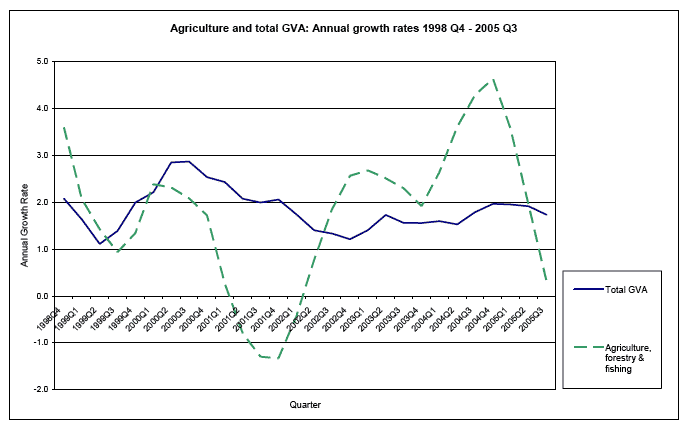
Source: Quarterly GVA Statistics, Scottish Executive
Total Income From Farming
Between 1990 and 1995 Scottish aggregate farm incomes in real terms almost tripled to reach a historically high level in 1995.
Compared to the mid 1990s aggregate farm incomes remain relatively low, however, 1995 was an exceptional good year. The fall from 1995-98 was primarily due to a strong pound, weak world commodity prices and the impact of BSE (Bovine Spongiform Encephalopathy) and then Foot and Mouth Disease. Since 1998, in real terms, Total Income from Farming ( TIFF) has now recovered to around 50% of the 1995 peak.
TIFF figures for 2005 show aggregate incomes to have fallen by 8.4% since 2004 (or fallen by 10.9% once inflation is taken into account). The figures show that in 2005 TIFF is estimated to be £436 million.
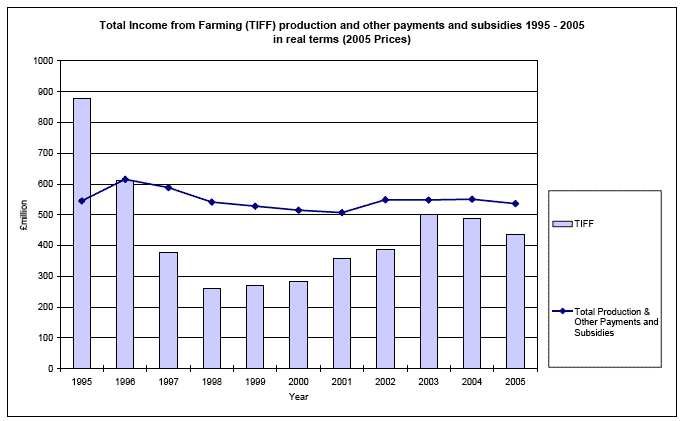
Source: Scottish Agricultural Output, Input and Output Statistics
Publication
Scottish Agriculture Output, Input and Income Statistics 2005 (Published 2006)
Net Farm Income
The trends in net farm incomes have broadly followed that for total income from farming, that is, incomes were historically high in the mid 1990s and have fallen back since that time.
In 2004, net farm incomes were lower across most sectors due to a combination of lower output prices and higher input costs. In particular cereal and potato prices for the 2004 harvest were lower than the previous year, whilst input costs such as fuel, fertilisers and agrochemicals increased. Dairy farmers saw a small increase in net farm income despite increased costs, primarily due to receipt of the dairy premium.
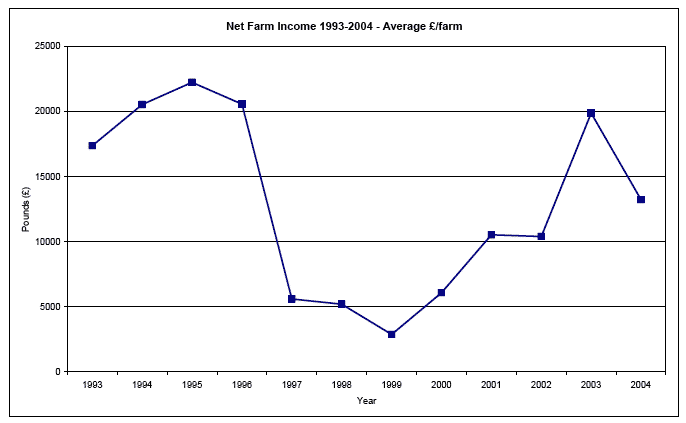
Source: Farm Accounts Survey, Scottish Executive Environment and Rural Affairs Department.
Web link
Farm Incomes in Scotland
Organic Farming
Up until 2002, there was a marked increase in the area covered by the Organic Aid Scheme but this has declined since then. Until recently, the bulk of the increase has involved rough grazing, however, the Organic Aid Scheme is now targeted more towards attracting the conversion of arable land, where the environmental benefits of converting to organic land are greater.
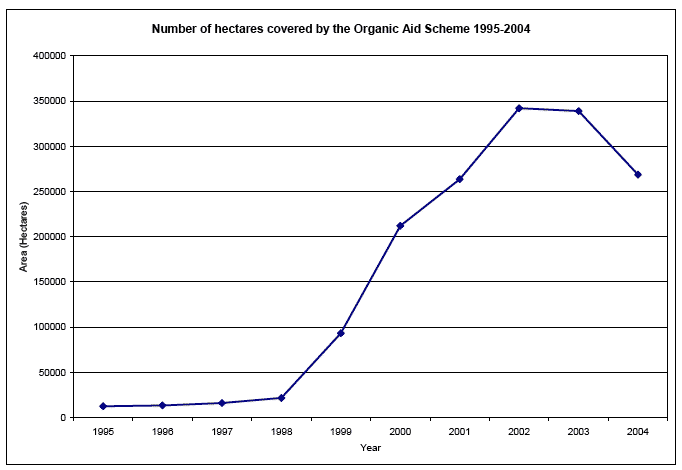
Source: Organic Annual Report
Publication
Organic Annual Report 2005 (Published 2005)
Fisheries
Aquaculture Support
Current data suggests that there are around 2,300 full-time equivalent jobs supported directly by aquaculture and that the fin-fish aquaculture sector had a farm gate value of approximately £340 million in 2004. Of this over £330m was Atlantic salmon production.
Production of salmon has increased steadily over the past few years, but there was a drop in production in 2004 as can be seen in the graph below.
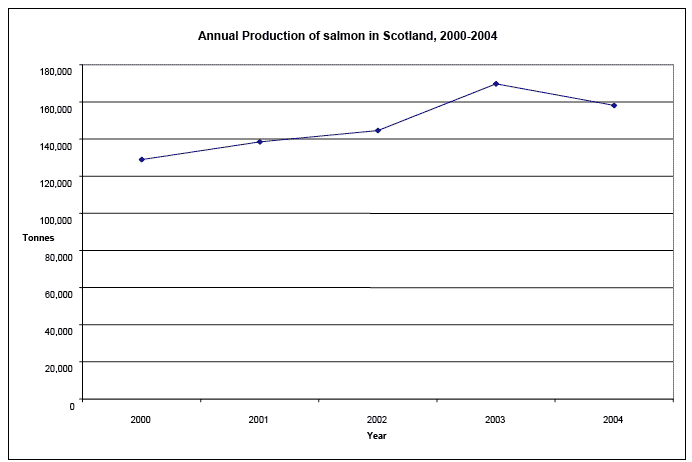
Source : Fisheries Research Services ( FRS)
Web link
Fisheries Research Services ( FRS)
Sea Fisheries
The graph below displays the value of landings by Scottish based vessels into the UK and abroad for the years 2000-2004 (in 2004 prices).
The value of demersal landings has fallen steadily over the period 2000-2004. In 2000, the value of demersal landed by Scottish based vessels totalled £174m, by 2004 this had fallen to £111m. This represented a fall of 39% in real terms over the period.
Over the same period, the value of pelagic landings have increased from £72m in 2000 to £85m in 2004.
The value of shellfish landings has also increased over the period. In 2000 the value of landings totalled £92m and in 2004, £104m.
In 2000, the value of demersal landings accounted for 53% of the total value of landings, by 2004 this had fallen to 37%.
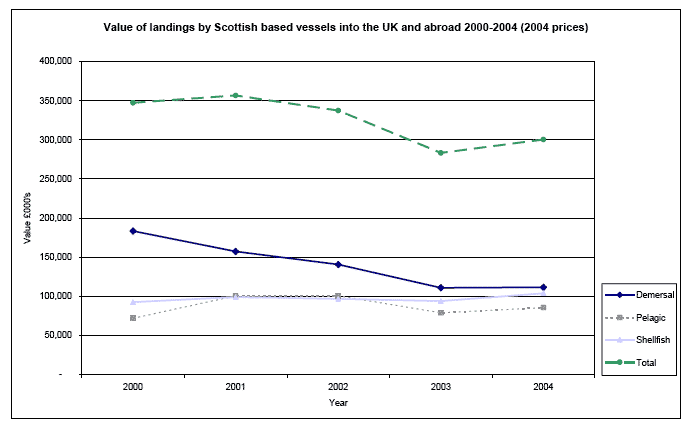
Source: Scottish Executive Environment and Rural Affairs Department
Food and Drink Industry
Scottish Produce Exports
The Global Connections Survey ( GCS) estimates food and drink exports since 2002. Food and drink manufacturing exports were £2,805 million in 2002, £2,900 in 2003 and £2,845 million in 2004. (Note that previous estimates from GCS have been revised downwards due to changes in the methodology).
Food and Drink GVA
The figure shows total gross value added ( GVA) at basic prices in Scottish food and drink manufacturing for each year 1998 to 2003. GVA in food and drink has fluctuated over the period; it increased to £2,096m in 2002 before falling to £1,962m in 2003.
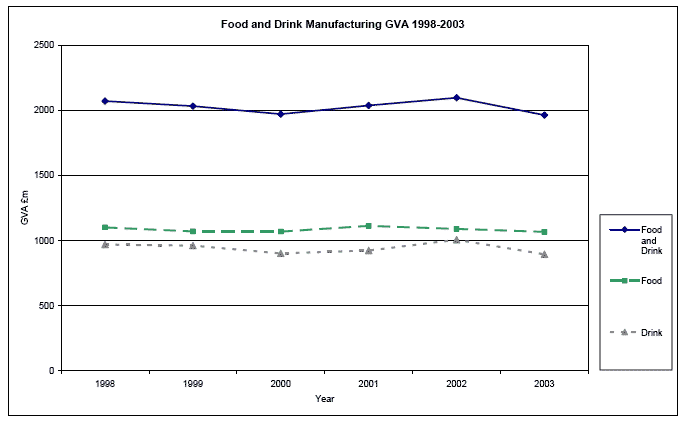
Source: Scottish Annual Business Survey ( SABS)
Forestry
Timber Harvested
A total of 6.9 million m 3 overbark standing of timber was harvested from forests in Scotland in 2004. This represents an increase of 88% from the 1994 level.
The last forecast of softwood conifer production (produced in 2000) indicated that timber availability would rise from an annual average of 6.2 million m 3 in the period 2002-2006, to 7.9 million m 3 in 2007-2011 and 9.1 million m 3 in 2012-2016. A new forecast will be published during 2006. Current hardwood production is around 50,000 m 3, but more could be produced if markets were available.
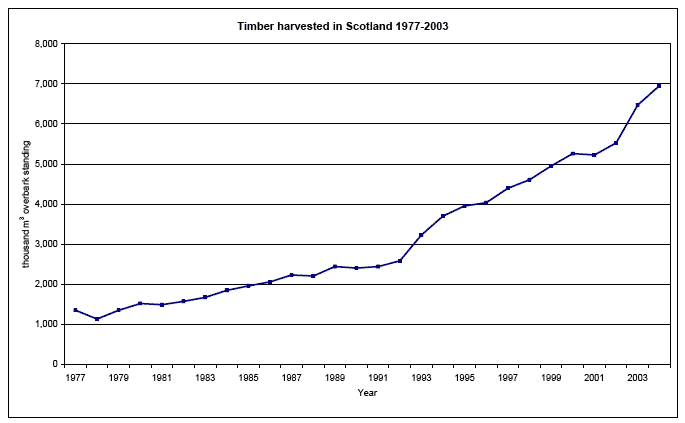
Source: Forestry Commission
Web link
Forestry Statistics
Sawnwood Production
A total of 2.3 million tonnes of logs (2.2 million m 3 underbark) were sawn by Scottish sawmills in 2004, producing 1.2 million m 3 sawnwood. This represents a 5% increase on the previous year and an increase of about 50% since 1994.
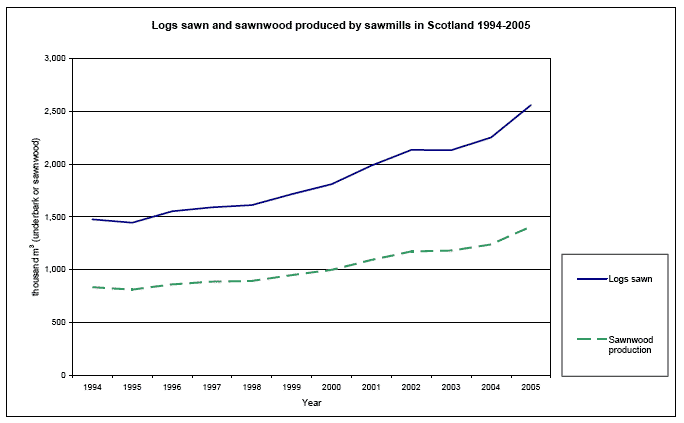
Source: Forestry Commission
Web link
Forestry Statistics
There is a problem
Thanks for your feedback